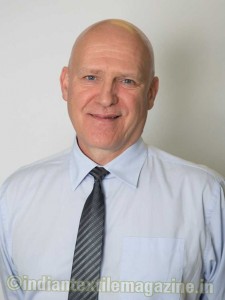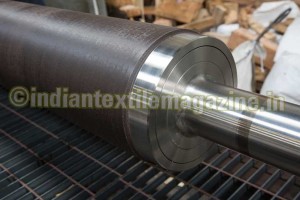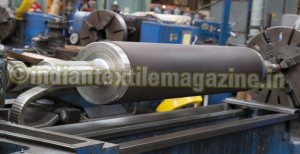
Ground-breaking innovations and detailed technology advances are producing buoyant sales for Richard Hough Ltd. (RHL), the specialist producer of de-watering, squeezing and calendering rolls for textile finishers.
The UK-based company has recently announced a major practical breakthrough with the development of squeeze rolls which automatically compensate for the deflection occurring under full load during water extraction. This, along with the earlier launch by RHL of the unique RoberteX fibre roll with full resistance to harsh chemicals, has attracted huge market interest and positive customer feedback.
After a year described by the RHL Managing Director, Mr. Anthony Ashton, as “a resounding success,” the company is now planning further product introductions over the course of 2014 and for ITMA 2015 in Milan. Meanwhile, commercial growth continues to focus on expansion in Asian markets where RHL has already established a strong customer base.
The latest deflection-compensating squeeze rollers avoid the need for a specially-profiled parabolic camber to counteract the varying pressure across the rolls. This led to problems at regrinding, with many Asian customers not having access to the sophisticated grinding machines able to form the required parabolic shape. Now, with the new rolls automatically compensating for any deflection, customers need only to have them reground to the normal parallel profile.
Says Mr. Anthony Ashton: “This is a huge breakthrough as regards roll accuracy and hence higher performance of the squeezing roll.”
The entire RHL squeezing roll range, including Roberto, RoberteX and Resilio, can now all be supplied in deflection-compensating design.
Global first in chemical resistance

The launch in 2013 of the RoberteX fibre squeeze roll was a global first – the only product of its type able to offer total chemical resistance in the range pH 0-14. This unique suitability for even the most aggressive and difficult textile processing environments, whether caustic or acidic, has made the RoberteX an immediate worldwide success, with sales continuing at high levels.
In the same period, RHL has been constantly developing its Resilio roll to offer fast payback and enhanced performance. Thanks to its novel dual-layer construction, the Resilio now achieves a 20 per cent increase over the de-watering rate of the conventional hard rubber rolls, effectively saving 20 per cent of customers’ energy costs.
Recently a major Chinese customer has reported that the Resilio has reached such a high level of de-watering efficiency that it no longer needs to use drying cylinders after the final squeeze.
The original and world-famous Roberto roll from RHL is also said to be selling well, achieving record sales in the past year in countries such as India, Indonesia, Morocco, the US and Pakistan.
Also popular are the Hough MaxExtractor rubber squeezing rolls, designed to provide end-users worldwide with a quality level equivalent to that from the major European OEMs.
For calender rolls, both cotton and Syncast construction, Hough products remain in the forefront of technological progress, as the ‘roll of choice’ for the world’s leading calender manufacturers, including Andritz, ramischGuarneri, Standex USA and Alliance Machine USA. In fact, says Mr. Anthony Ashton, “virtually every geotextile calender in the US is now fitted with Richard Hough Syncast rolls.”

RHL’s business strategy continues to spotlight the booming textile countries of Asia, especially India, China, Bangladesh and Indonesia, while the US remains an important and sizeable market. As an example, sales to India soared during 2013, increasing by as much as 50 per cent over the previous year, with new orders from at least nine major customers there. This year, the company plans to foster still more expansion in Asia, supported by its participation in exhibitions such as Saigon Textile and Garment (Vietnam) and Intertex (Jakarta).
Future plans, sustainability target
A number of new RHL developments are already in the pipeline, including the imminent launch of a Roberto roll with improved elasticity and chemical resistance. For ITMA 2015, the company is readying what is described as “a completely new de-watering concept.”
For the future, RHL is focused on the bigger picture, understanding the requirement to conserve energy while also helping textile processors optimise their profitability.
Mr. Anthony Ashton outlines the key issues and potential changes: “Squeezing technology cannot stand still. With the squeezing rollers of the future, we will be moving towards a sustainable world, with the main aim of saving valuable energy generally, as well as saving costs for our customers. It is likely that expensive vacuum extraction will be made obsolete by the huge innovations in squeezing roll technology. Looking further ahead, new polymers and composites are the way forward, to further improve squeezing roll performance.”